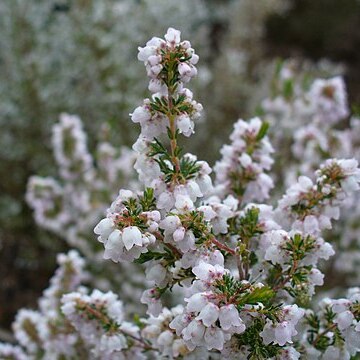Erect, compact, dwarf shrub, 0.3-0.5(-1.0) m high. Leaves spreading, erect when young, 1.6-3.2 mm long, linear, glabrous, ciliate when young. Flowers 4-nate. Calyx sepals 1.0-1.6 mm long, ovate or lanceolate-ovate, acute, subscarious, ciliate or naked, keeled, glabrous. Corolla 2.0-2.6 mm long, generally broad cyathiform; tube sometimes obconic, widened at mouth, white to rosy to pink; lobes erect, variable in shape and length 1/2-3/4 length of tube, interstices of limb segments acute at base. Anthers included, ± 0.4 mm long, obliquely cuneate-oblong, smooth and glabrous, aristate; pore 3/4-7/8 length of theca; appendages narrow, rough-edged, not fringed, ± 1/2 length of theca. Ovary glabrous; style straight, included; stigma capitellate, small. Flowering time July-Dec.
Like E. mauritanica , erect, often compact, floriferous shrublet to 50 cm. Flowers small, broadly bell-shaped, pink to white.

